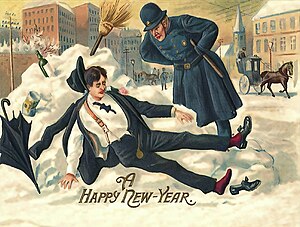Binge drinkers
| Binge drinking | |
|---|---|
 |
|
| 1912 US. Happy New Year postcard | |
| Classification and external resources | |
| Specialty | Psychiatry |
| ICD-10 | F10 |
| ICD-9-CM | 305 |
Binge drinking, or heavy episodic drinking, is a modern epithet for drinking alcoholic beverages with an intention of becoming intoxicated by heavy consumption of alcohol over a short period of time.
It is a style of drinking that is popular in several countries worldwide, and overlaps somewhat with social drinking since it is often done in groups. The degree of intoxication, however, varies between and within various cultures that engage in this practice. A binge on alcohol can occur over hours, last up to several days, or in the event of extended abuse, even weeks. Due to the long-term effects of alcohol misuse, binge drinking is considered to be a major public health issue.
Binge drinking is associated with a profound social harm, economic costs as well as increased disease burden. Binge drinking is more common in males, during adolescence and young adulthood. Heavy regular binge drinking is associated with adverse effects on neurologic, cardiac, gastrointestinal, hematologic, immune, musculoskeletal organ systems as well as increasing the risk of alcohol induced psychiatric disorders. A US-based review of the literature found that up to one-third of adolescents binge-drink, with six percent reaching the threshold of having an alcohol-related substance use disorder. Approximately one in 25 women binge-drinks during pregnancy, which can lead to fetal alcohol syndrome and fetal alcohol spectrum disorders. Binge drinking during adolescence is associated with traffic accidents and other types of accidents, violent behavior as well as suicide. The more often a child or adolescent binge drinks and the younger they are the more likely that they will develop an alcohol use disorder including alcoholism. A large number of adolescents who binge-drink also consume other psychotropic substances.
...
Wikipedia
